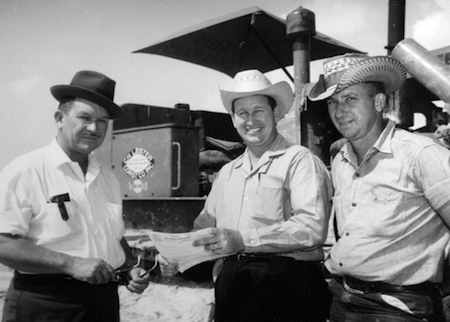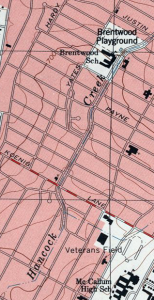Copyright 2011-2023 Susan Burneson. All rights reserved. Kindly talk with us before reproducing any content you find on the website.
Arroyo Seco means “dry creek” in Spanish. The term also refers to an intermittently dry creek — a good description of the waterway through our area today. Many neighbors still call this waterway Arroyo Seco (or Seca). On the United States Geological Survey Austin East map, it’s Hancock Creek. On City of Austin and Federal Emergency Management Agency documents and maps, it’s the Hancock Branch of Shoal Creek. On the Google map, it’s labeled simply Dry Creek.
By the mid-1940s, after the end of World War II, most of the area that became Brentwood and Crestview was outside the Austin city limits, primarily farmland with few trees. (More about the neighborhoods’ boundaries, below.) As veterans returned home, married, and began to raise families, the two neighborhoods began to be developed in earnest as part of Austin, but the unpaved streets and swampy areas near Hancock Creek were challenging for builders and early residents.
In 1951, Al Kirby and his family moved to a brand-new house on Payne Avenue in Brentwood. In the video clip below, Al talks about Arroyo Seco and an adventure they had one night on the way home from the drive-in.
So, it became imperative to dig a deeper channel for the waterway, to alleviate the poor drainage near the creek. This also created more usable land to build homes for the young families moving to the two neighborhoods.
 Longtime Crestview resident Beverly Lester remembers that her father, C. H. Lester (at far left in the photo) helped “build the arroyo.” He owned the C. H. Lester Construction Company and was a dirt excavator.
Longtime Crestview resident Beverly Lester remembers that her father, C. H. Lester (at far left in the photo) helped “build the arroyo.” He owned the C. H. Lester Construction Company and was a dirt excavator.
(Read more about Beverly’s son, juggler “Red Ryder” Schwartz, here.)
If you’ve lived in Austin a while, you’ve probably noticed on most Brentwood streets and on all Crestview streets there is no 1600 block. On our street, for example, we live at 1517 and next door is 1701. I’m thinking this unusual numbering is because of the way the creek meanders through the area and addresses were numbered generally from south to north as the two neighborhoods were developed beginning in the 1940s.
 There are a few streets with 1600 blocks in Brentwood — North Loop between Jim Hogg and Arroyo Seco; Houston between William Holland and Jim Hogg; and Ullrich between William Holland and Arroyo Seco.
There are a few streets with 1600 blocks in Brentwood — North Loop between Jim Hogg and Arroyo Seco; Houston between William Holland and Jim Hogg; and Ullrich between William Holland and Arroyo Seco.
For eight blocks, from Koenig Lane up to Brentwood St., the street Arroyo Seco and the dry creek that divides it serves as the 1600 block, with 1500s on the east side and 1700s on the west side.
Addresses in Crestview, from the south side of Justin, just north of Brentwood Park, up to Anderson Lane jump from the 1500s to the 1700s within one block.
It’s confusing for anyone who’s new here. I can’t tell you how many times I’ve seen delivery trucks speed by, only to come to a quick stop and back up to find our house.
On this 1940s map, the creek was labeled Hancock Creek, named for Austinite John Hancock. He owned land that became Rosedale, Allandale, Brentwood, and Crestview, and the creek flows through all of them and then joins Shoal Creek.
(If you’re not familiar with the neighborhood, Brentwood and Crestview are between Lamar Boulevard and Burnet Road, with Crestview from Anderson Lane to Justin Lane, including property on the south side of Justin between Hardy and Reese, and Brentwood from property on the north side of Dwyce Drive down to West 45th Street.)
Coming Monday, 9/26/11: Hancock Creek/Arroyo Seco, Part 3—Is it Arroyo Seco or Arroyo Seca?
